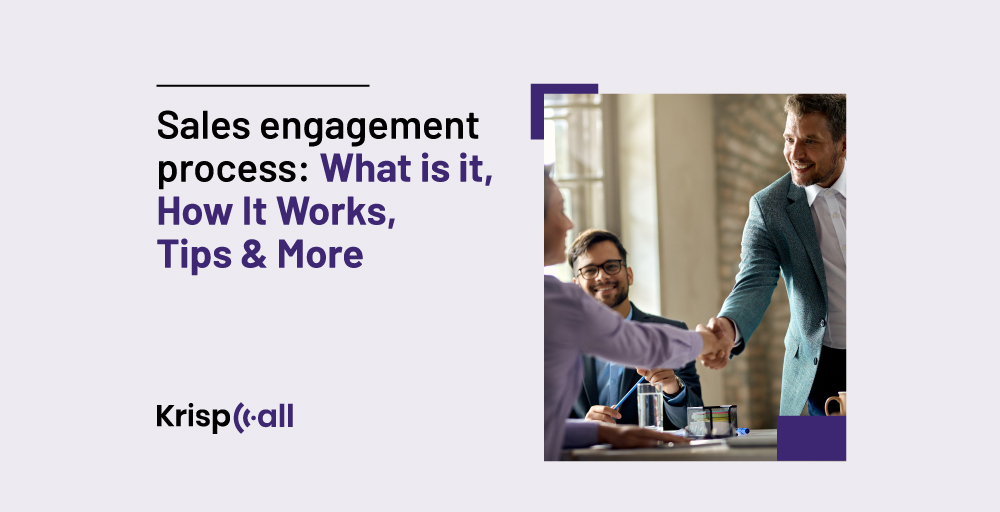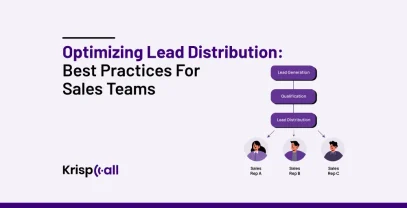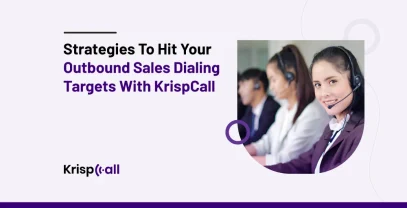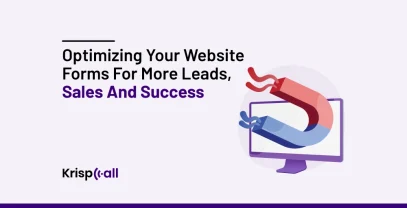In today’s competitive landscape, simply contacting a potential customer isn’t enough. You need a strategic approach to capture their attention and guide them towards a purchase.
As per the study done by Harvard Business Review, 92% of executives agree that effective customer engagement is important for their organization to grow.
Hence, sales engagement is the art of creating meaningful interactions with potential customers that transform one-off interactions into lasting relationships and, ultimately, closed deals.
But how can you make your sales engagement process truly effective?
Here, In this blog, we are going to explore the sales engagement process, how it works, and some tips to make it more effective to grab the maximum attention of the customers.
🔑 KEY HIGHLIGHTS
- The sales engagement process is the approach and procedures that the sales team follows from the first contact with potential customers to the end of the deal.
- The benefits of sales engagement include increased revenue and shorter sales cycles, enhanced customer relationships, brand advocacy, etc.
- Sales engagement increases sales through personalization, automated tools, content strategy, multichannel engagement, data-driven decisions, etc.
- Tips for implementing sales engagement include enhancing inbound/outbound interactions, choosing preferred communication channels, conducting employee surveys, using engagement software, real-time analytics, and continuous process adjustments.
What is Sales Engagement?
Sales engagement is the strategy used by the sales team from the beginning of the contact with the potential customers till the deal is finally closed. The main motive for sales engagement is to get a positive response from prospects at each touchpoint.
With this knowledge, salespeople can adapt their approach and present clients with options that speak to them personally. In addition to increasing conversions, effective sales engagement fosters client loyalty and retention.
Example: sending personalized emails to prospective clients addressing their particular needs or problems. You can also book and host meetings to show how your product or service can solve their problems. Besides, you can try running product demos and leaving detailed voicemails, which can be a great way of showing the product’s benefits and keeping people engaged.
What are the Benefits of Sales Engagement?
The implementation of a sales engagement process simplifies things. It not only enhances your revenue but also simplifies the internal tracking process. There are several benefits of sales engagement plans, and some of them are as follows:
1. Increased Revenue Shorter Sales Cycles
When the sales team effectively engages with prospects, it results in a shorter lead cycle, eventually increasing revenue for the company. The shorter the sales cycle, the faster deals are closed, which will save a lot of time and resources for both your team and the customer.
Therefore, with effective sales engagement techniques, businesses can make more sales in less time, ultimately boosting profits and efficiency.
3. Enhanced Customer Relationships
Sales engagement enhances customer relationships by building trust and loyalty. Regular personalized interactions with customers make them feel valued and help them strengthen their relationships with the company.
This action will lead to longer relationships and repetitive business since satisfied customers are more likely to do business again. Also, there is a high chance they will recommend your products or services to others.
3. Improved Lead Quality
A better sales engagement strategy improves lead quality by increasing people’s interest in your product/service. By focusing on engaging with the right prospects and tracking their interactions, businesses can identify the most engaged and qualified leads.
It further allows sales teams to focus their efforts on the prospects that are most likely to convert. This way, your team can spend their time and resources more efficiently, leading to more successful sales outcomes.
4. Better Customer Insights
When the sales team continuously engages with the customer, they gain deeper and more valuable information about their needs, preferences, and challenges. With this knowledge, the sales team can personalise their approach and offer more relevant solutions.
With better tracking of the customer engagement process, customers’ preferences can be studied in-depth. The sales team can improve their communication strategies, leading to higher customer satisfaction.
5. Increased Sales Productivity
Sales engagement platforms not only enhance workplace efficiency and automate repetitive tasks, but they also provide data that helps the sales team prioritize. This increase in efficiency causes a great rise in sales productivity.
According to a study, organizations that invested in customer engagement reported a 70% increase in their revenue. These platforms really allow the sales team to optimize their processes and get better results. It will enable them to achieve higher levels of business success in their sales efforts.
6. Brand Advocacy
Your sales team’s active involvement with customers generates a high-quality, happy relationship, which in turn generates more sales. Content customers are more likely to turn into regular customers of your brand.
Likewise, past customers will talk about their good experiences, telling others to use your products or services or to refer somebody to you. Word-of-mouth advertising makes you the first choice for new customers, and at the same time, your brand gets more popular, which results in even more sales and growth for your company.
👍 Also Read: How to Turn HubSpot CRM into a Top Sales Engagement Platform?
How to Increase Sales with Sales Engagement?
To increase sales with sales engagement strategies, here are some tips you can follow:
1. Personalise Conversation
Personalization plays a big role in enhancing sales. Every customer is unique. Thus, different strategies should be implemented. Make your messages suit each individual’s particular needs or problems instead of using a general approach to everybody.
Today, customers are increasingly using several channels, such as email, LinkedIn, and messaging apps. These channels can be used to increase the touch points. The one-on-one method of working with clients enhances your bond with them and, in turn, leads to an increase in sales.
2. Multichannel Engagement
Sales engagement has to be combined with multiple channels like email, LinkedIn, phone calls, and messaging apps to connect with prospects.
You need to find out what customers’ preferred method of communication is. They might like talking on LinkedIn, or they may prefer speaking to you on the phone. By knowing your customers’ preferences, you can select the best channels for successful interaction. By using the most favored channels, you can communicate better, and sales will rise.
3. Use Sales Playbooks
Sales playbooks are structured strategies that help the sales teams deal with prospects effectively and easily. When integrated into your sales process, sales playbooks can easily streamline workflows, enhance consistency, and eventually lead to increased sales results.
With this tool, sales reps can access important content and best practices, which will help them improve their sales approach, resulting in better performance and higher success in closing deals.
4. Use Automation Tools
The automation tools help automate routine tasks like email outreach, lead scoring, and follow-up reminders, which in turn increases the team’s productivity. Automated email sequences can help stimulate leads; gradually, the conversion rate will become higher.
Through the automation of work processes, you not only guarantee uniformity and productivity in your sales activities but also excel in them. Additionally, these tools help shorten the sales cycle, enhance productivity, and improve overall sales performance.
5. Build Content Strategy
A well-defined content strategy is the basis of a sales engagement model. An effective content strategy involves discovering the requirements and preferences of your target audience.
It involves creating interesting content like blog posts and eBooks and then distributing it through different channels such as social media, email, and your company website. By providing informative and useful content, you earn the trust of clients and eventually increase sales.
6. Data-Driven Decision Making
Data-based decision-making is a must to boost sales through sales engagement. It includes utilizing information and insights collected from various sources to create sales strategies. By studying data like customer demographics, behavior patterns, and past sales performance, you can determine where to put your efforts.
For example, the data can be used to determine the effectiveness of a certain market campaign that generates high-quality leads. Through data-driven decision-making, you can recognize opportunities and optimize your sales process, resulting in the closing of more deals.
7. Implement Sales Engagement Strategies
A sales engagement strategy is a plan that addresses the ways and techniques the sales agent uses to communicate with potential and existing customers. It comprises the tasks of identifying potential customers and their requirements and deciding the most effective means of communicating with them.
A good sales strategy also entails setting specific objectives, such as raising the number of conversions and enhancing customer satisfaction, the way you are given feedback, etc. By establishing a clear sales engagement strategy, your team can successfully interact with prospects, establish their trust, and ultimately close the sales.
Tips to Implement Sales Engagement
Implementing an effective sales engagement program requires a combination of the right sales strategy, good timing, and the right communication channels. Also, the processes should be continuously monitored and adjusted.
Besides this, here are some tips for implementing sales engagement:
1. Enhance Both Inbound and Outbound Interactions
To successfully achieve the goal of sales engagement, it is necessary to improve both the inbound and the outbound interactions. For inbound leads, ensure your website is well-designed, and sales reps have scripts and email templates to follow.
For outbound leads, the main task is to focus on customer interest by using exciting messages and providing thought-leadership content. By optimizing inbound and outbound engagement, you will enhance communication, and hence, sales will be boosted.
2. Choose the Right Channels for Communication
It is important to choose the correct communication channels for sales engagement. Rather than dispersing efforts through various channels, concentrate on the ones your prospects really like.
For example, if your prospects are active on LinkedIn, make the most of them by connecting with them on that platform rather than bombarding them with emails. Knowing the type of customers you have is the main thing in selecting the most suitable communication channels. Thus, by doing this, you can have a good connection with the clients and enhance sales.
3. Conduct Frequent Employee Engagement Surveys
Sales engagement also involves conducting surveys of the salespeople to collect their opinions and observations. These surveys can evaluate the team members’ motivation and satisfaction levels.
Through the constant search for feedback from the employees, you can conclude what needs to be improved to create a good work environment. Employee feedback aids in developing training programs and initiatives to support the sales team’s growth and success. Hence, these surveys create a more involved and dedicated sales force, producing better results and performance.
4. Use Sales Engagement Software to Save Your Team Time
Sales engagement software allows you to boost your sales by engaging your audience effectively and saves a lot of time. These platforms help to reduce the repetition of tasks of sales reps, such as the work on emails, calls, lead tracking, etc. This will allow the agents to focus on relationship-building and closing deals.
Besides, these tools provide data on the prospect’s behavior and level of engagement, which helps to determine which prospect is more important and improves sales strategy. So, with the automation of workflows and centralized systems software, sales processes become more efficient and productive.
5. Track and Exploit Real-time Analytics to Improve Sales Engagement Processes
Sales engagement platforms provide valuable data on prospects’ interactions, such as email open rates, website visits, and content engagement. By studying this data, sales teams can detect trends, find patterns, and identify areas for improvement.
This data-based strategy allows you to improve your messaging and adjust your outreach. Using real-time analytics, sales teams can make better decisions, adapt to the changing market conditions, and achieve better results through sales engagement strategies.
6. For Ongoing Success, Set a Process for Making Adjustments
Through sales engagement, ongoing adjustments should be made to enhance sales and ensure sustained success. Performance indicators, customer feedback, and market trends should also be regularly monitored to identify weaknesses that need improvement.
The structured work helps adapt and refine the strategies so sales teams can be swift and responsive to market changes. Through the cycle of trial and recovery, the sales engagement tactics are continuously optimized, which leads to sustained growth and improved outcomes over time.
Conclusion
Mastering the sales engagement process is vital for driving success in your business. By implementing the right strategies and utilising automation tools, you can streamline your sales activities, increase productivity, and ultimately boost revenue.
Remember to prioritize building genuine connections with your prospects, providing valuable insights, and offering personalized solutions. With dedication and the right approach, you can effectively engage customers and close more deals.
FAQs
What is a sales engagement platform?
A sales engagement platform is a software tool that helps sales teams effectively engage with prospects and customers throughout the sales process. It typically includes features like email tracking, automated workflows, and sales analytics to streamline communication and improve sales productivity. Sales engagement platforms aim to enhance the efficiency and effectiveness of sales interactions, ultimately helping teams close more deals.
What is the difference between sales engagement and sales platform?
The sales engagement focuses on how sales teams interact with prospects, including communication methods and strategies.
A sales platform encompasses a broader range of tools and functionalities that support the entire sales process, including CRM, pipeline management, and analytics.
How do you engage with sales?
One can engage with sales by actively interacting with potential customers, understanding their needs, and offering solutions. This can be further facilitated by email, phone calls, social media, or face-to-face meetings. You can also engage by asking relevant questions and providing personalized information.





